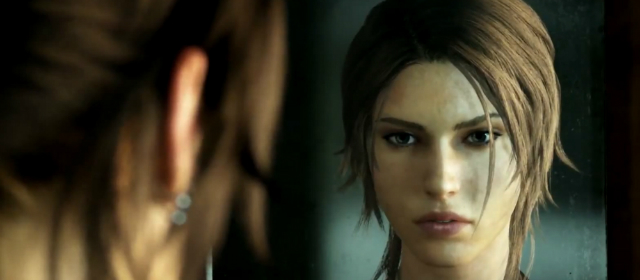Name: Lara Croft
Game: Tomb Raider (2013)
Species: Human
In her own words: “I don’t think I’m that kind of Croft.”
This is the first episode of Character Select not to contain spoilers about the character it’s based on. However, it does contain Ghost in the Shell spoilers, so if you’ve yet to see the 1995 movie, exercise caution.
“You talk about redefining my identity. I want a guarantee that I can still be myself.”
“There isn’t one. Why would you wish to? All things change in a dynamic environment. Your effort to remain as you are is what limits you.”
– Major Motoko Kusanagi and the Puppet Master, “Ghost in the Shell” (1995)
Ghost in the Shell is a science fiction series that uses part-human, part-cyborg characters to explore themes of identity and existence. In its futuristic world of cyber-terrorism, a “Shell” is loosely defined as the body, in most cases a complex mix of cybernetic implants and flesh, while the “Ghost” is often understood as the mind, or consciousness. However, the series’ various characters frequently question the latter because in this world, a mind can be copied and memories can be edited and rewritten.
In Mamoru Oshii’s 1995 film Ghost in the Shell, Major Motoko Kusanagi, a squad leader at an intelligence and defence organisation, sets off in pursuit of the Puppet Master, an apparent hacker who actually turns out to be a rogue A.I. What begins as a tale of corporate sabotage soon turns into a philosophical allegory as the Puppet Master causes Kusanagi to question what part of her, if any, really contains her essence. He does this because he wants to convince her to “breed” with him, because without another he can only copy himself, leaving him vulnerable to destruction.
Eventually, the two merge, and the resulting ghost remains in Kusanagi’s part-human head (on a new body, the original having been destroyed in an unfortunate incident involving a helicopter and a tank), forming a brand new creature that, like a real human, is at once both and neither of the two entities who spawned it.
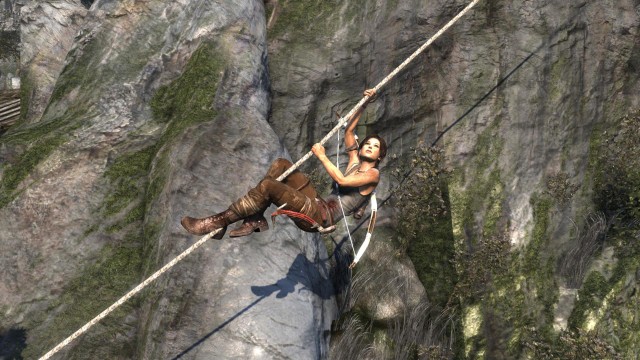
Ghost in the Shell is relevant here because the 2013 incarnation of Lara Croft has much in common with the mysterious “offspring” of the Puppet Master and Kusanagi. Like that entity, she was created so that fragments of her predecessors could live on in a new form, one step ahead of the changing environments that will overwhelm her if she ever stays still for too long.
The differences between “old” Lara and this new creature are striking. The new Lara is realistically athletic, not superhumanly acrobatic. She is vulnerable, not invincible. She is self-questioning, not sociopathic. These changes were wholly necessary, though it’s important to note that old Lara was a spectacular creation. Like the Puppet Master, she transcended the purpose for which she was created (to star in an Indiana Jones game but not actually be Indiana Jones) and broke out into the wider world, becoming, like a Spice Girl, an unintentional poster-girl for Cool Britannia and post-feminism alike.
But she was too perfect. “Overspecialise, and you breed in weakness,” remarks Kusanagi, who could very well have been describing Lara. “It’s slow death”. You see, just as a population with limited diversity can be brought to its knees by a single predator, and a computer virus that never changes can eventually be stopped, so a video game character that never develops will eventually become irrelevant, no matter how powerful she once was.
Lara was once untouchable. Her gymnastic platforming brought true three-dimensional action to the adventure genre, and her looks, voice and attitude made her arguably the most recognizable video game character in the world. But she was too well-adapted to a world where graphics were figurative, rather than literal, where female game protagonists were a novelty and where no-one really had console shooting figured out yet.
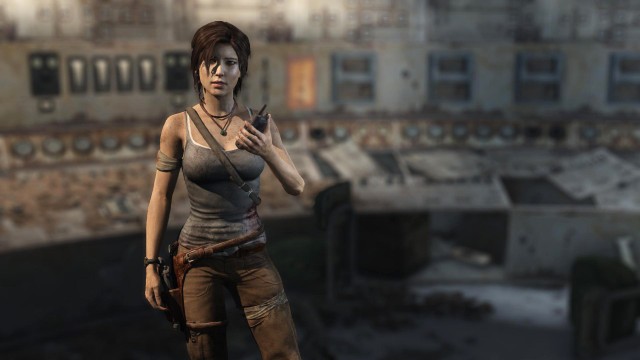
She also came along at a time when, buoyed by a New Labour government, Euro ’96, Damien Hirst and the Blur/Oasis/Pulp triumvirate, British people took a break from their default mode of vague embarrassment about their hoard of post-colonial wealth and started wearing Union Jack T-shirts again. Thus, they were quite happy to join a blue-blooded member of the landed gentry as she frolicked around the world stealing things from poor countries.
But then the environment began to change around her, and like an animal that fails to adapt, Lara struggled. Huge advances in three-dimensional gaming meant that she was soon usurped as the queen of large-scale platforming. The third-person shooter blossomed, making Lara’s context-sensitive auto-aim look like a tired exercise in resource management. Subtle, complex female characters started to offer players a depth that Lara could not, while at the other end of the scale the likes of Bayonetta started to usurp her as otherworldly pin-up material.
The War on Terror and the fraudulent search for WMDs removed the rose-tinted glasses through which the West, particularly the British, viewed Lara’s wantonly destructive approach to international relations (“she was never one for diplomacy,” remarked Charles Kane in Tomb Raider: Chronicles), so they turned instead to a new breed of self-conscious anti-hero popularised by the Grand Theft Auto games. Suddenly, the woman who was once best at everything became the woman who didn’t fit anywhere. Lara had overspecialised, and she had become weak.
The critical and commercial failure of Core Design’s last game, Tomb Raider: The Angel of Darkness, saw custodianship of the series passed to an American studio, Crystal Dynamics. The new developers used physics and a magnetic grapple to fix the platforming and added some friendly NPCs and the breathy voice of Keeley Hawes to address the characterisation issues, but technology and polish could not rectify the fact that Lara had become as much a relic of the past as the artefacts she sought in buried tombs.
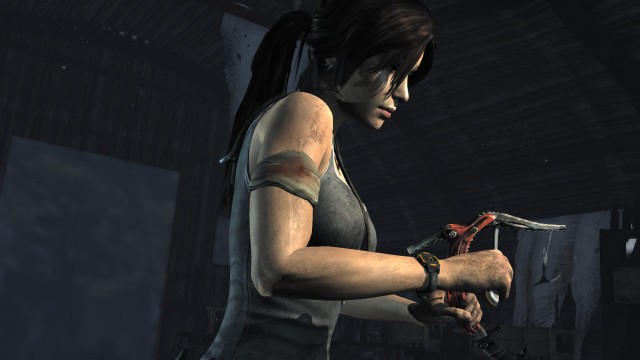
The previous Tomb Raider game, Underworld, exhibited the problem perfectly. Marketed (just as its two predecessors were, incidentally) as a “return to the series’ roots”, Underworld had everything Tomb Raider fans thought they wanted: Globetrotting, ancient ruins, vast environmental puzzles, superhuman gymnastics, barely any combat and an inexplicably motivated heroine. And yet, following a slightly embarrassing attempt on then-publisher Eidos’ UK PR firms’ part to inflate an underwhelming Metacritic score, sales of the game were disappointing.
If Lara at her very best couldn’t make a game work, what then? Again, it is the Puppet Master who has the answer. “Life perpetuates itself through diversity, and this includes the ability to sacrifice itself where necessary. Cells repeat the process of degeneration and regeneration until one day they die, obliterating an entire set of memory and information. Only genes remain. Why continually repeat this cycle? Simply to survive by avoiding the weakness of an unchanging system.”
The cells of cocksure, gymnastic Lara were tired. The memories and the information they carried belonged to the past. Her genes had to be passed on if they were to survive. And as the Puppet Master knew only too well, the only way to do that was to find another organism with whom to reproduce.
It is interesting, and perhaps a little incestuous, that one of the many organisms she eventually found was quite possibly descended from her in the first place. Back in 2007, Uncharted: Drake’s Fortune took the platforming, shooting and tombs of Tomb Raider and fashioned them into a linear, cinematic, character-driven narrative. Its protagonist, Nathan Drake, was just “a guy in a T-shirt”, a lovable, relateable jerk from a broken home with a boyish lust for adventure and discovery.

The Uncharted games’ incredible success is down to the fact that they deftly combine spectacular adventure with human stories of friendship and love. In each of the three games, Nathan not only saves the world but completes a satisfying character arc. It is this development that Lara was missing, and this which Crystal Dynamics saw as the fragment of genetic diversity that would give her relevance and power in an age where the “are games art” debate had long since been put to bed by anyone who knew what they were talking about.
Video games let us become something that we are not and let us live impossible lives. We take for granted the incredible things we can do as their protagonists, and rarely do we give a moment’s thought to what it would mean if a real person did those things too, or what they might have to have been through to even be able to. New Lara’s accomplishment – that she makes us experience those things – is something she is only able to do because she has cinematic narrative gameplay in her genetic code. It enables her to make us feel the impact of her every decision to stay alive, which is of course an implicit decision to destroy a small part of herself.
New Lara’s character-driven motion capture, which gives her a weight and believability that her old gymnastic moveset could not, has a large part to play in this, and again it gives her far more in common with Nathan Drake (particularly his famous trek through the Rub’ al Khali desert) than she does old Lara. But the structure of her adventure owes more to another family of games, one which gives us a sense of Lara’s growing power and confidence. Its influence is apparent when Lara returns to an old area and crosses it using a rope bridge launched from her bow, blasts through a previously impassable barrier using an upgraded shotgun or uses a newly strengthened axe to force a heavy door.
These games, which put players in a near-open world that gradually opens as they gain items and abilities, have their roots in The Legend of Zelda series and have been iterating and cross-breeding with other action-adventure games ever since. The most prominent recent iterations have been Rocksteady’s phenomenal Batman series, which drip-feed Batman gadgets and upgrades that gradually give him access to every hidden item in the games’ open worlds.
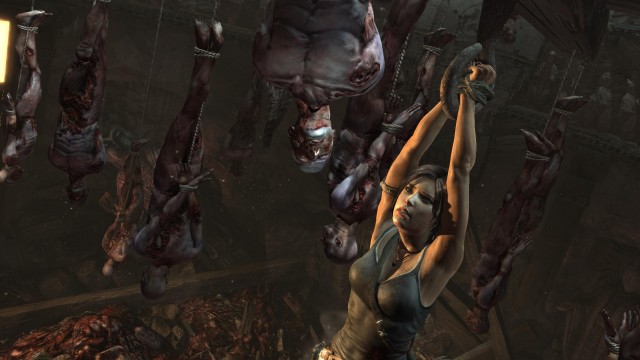
With her upgradeable bow, axe and shotgun that let her build paths over, around and through the island of Yamatai, Lara lets the player experience a gradual empowerment that perfectly matches her own growth and development as a character. Old Lara might have picked up the odd rocket launcher on her travels but, by and large, her powers at the beginning of each game matched those at the end (Angel of Darkness’ ill-advised “RPG” elements notwithstanding), and thus would never have been able to convey a sense of growth through gameplay mechanics.
The success of new Lara is now undisputed, but it raises a question, at least from a gamer’s, if not a philosopher’s perspective. And that is: Why use Lara’s ghost at all? Why not just make a new character? Female, possibly, with above average physical and mental capabilities? Cast into a profoundly hostile environment for the sake of character development? She wouldn’t have to be a well-spoken British archaeologist called Lara Croft to be worth controlling.
The cynical answer is that Tomb Raider is a brand that’s too big to die, that keeping it alive is more important (and less commercially risky) than developing a new IP. That while “Lara Croft” could ship a game called “Tomb Raider” (even if it hardly had any tombs in it), a brand new character couldn’t shift the same number of units of a game with a more accurate name (I propose “Mudlark”).
There’s some truth to this argument, but it’s not the whole story. You see, a large part of the tension and excitement in Tomb Raider comes from knowing what Lara will eventually become. The understanding, always at the back of your mind while you play, that every step brings this uncertain girl a little closer to becoming a fearless woman, is what makes it so thrilling. Just as the knowledge that a tragedy always ends badly makes watching them all the more compelling, so knowing exactly how exceptional Lara will eventually become adds a shot of adrenaline to every dark, nervous moment.
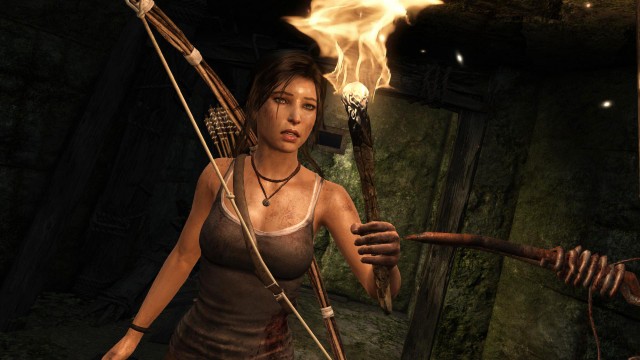
New Lara is not the same woman that first stormed Atlantis in 1996. That character and the people who made her understood that, like Kusanagi, she could no longer remain herself and go on living. But the knowledge that pieces of old Lara, in all her bold, ferociously capable glory, lie behind the softness of the new character makes her stark vulnerability fascinating and the game’s ultimate payoff thrilling.
In a way, Tomb Raider is almost a metaphor for itself. Adrift in an almost impossibly hostile environment, Lara discovers that while vital for uncovering Yamatai’s secrets, her brains and knowledge are not enough to survive, and that she must learn from killers how to kill if she is to survive. In the same way, the ghost of Lara Croft that we’ve followed for so long learned that old tomb raiding ways won’t keep her alive in the current climate, that she must combine them with the skills of the strongest characters of this generation to thrive. At the end of the game, a survivor is indeed born, though whether it is the 21-year old adventurer of the 17-year old video game series, only time will tell.
All the screenshots in this article are from the PC version of the game, and are used with kind permission from Katie at TombRaiders.net.


